When we have students re-engage with material again and again at spaced intervals, we are helping students cement learning to memory.
One of the best ways to create re-engagement with your learners is by providing ample opportunities to respond (OTRs).
- Micro. You are chunking and chewing content that has been delivered. Students get time to digest and process taught information.
- Interactive. Students are involved in their learning
- Reinforced. Students are asked to answer, comment or complete an activity about what they are learning.
- say things
- write things
- do things
1. Choral Response:
- The teacher asks all students the same question, gives wait time, and then gives a signal that cues students provide a response in unison.
- Example:
- Teacher: What is the capital of Kansas?
- Give wait time
- Students: Topeka
2. Jigsaw
- The teacher introduces a subject to be studied. The teacher then assigns students to a "home group" of 3-5 students. Each student in the "home group" is tasked to become an expert for a particular portion of the subject they are studying by getting into an "expert group" with other classmates.
- The teacher provides each "expert group" with a resources (text selections, videos, websites, etc.) in order to become an expert.
- After appropriate time studying, reading and dialoging with expert groups, students return to their "home groups" to teach the other members what they learned.
- Resource: Check out this video from Reading Rockets to watch a jigsaw strategy in action.
3. Numbered Heads Together
- Numbered heads together is a great strategy that is helpful in reviewing taught concepts. Teachers will create groups and give each group a number 1-6. Within each group, members are also given a number 1-6.
- The teacher asks a question and members of the group put their "heads together" to discuss the answer.
- The teacher rolls two dice. The first dice is the group that gets to answer. The second dice is the person that gets to answer. Only the student within the group whose number is rolled may speak.
- The student will stand and say, "WE decided the answer is...."
- If the student is right, that group gets a point. If the students is wrong, the student does not get a point.
- Example:
- Teacher: Which character traits are stated directly, and which are implied by the author?
- Numbered heads get together to discuss
- Teacher: Rolls 2 dice (ex: 1, 6--group 1, member 6 answers)
- Student answers--if correct the group earns a point.
- Resource: Check out this video to see numbered heads together in action!
4. Whip Around
- This strategy actively engages all students and encourages participation by all. Students will write down answers to a prompt and quickly share their responses with their class.
- Example:
- Question
- Pose a prompt that has multiple answers. Have students write down as many responses as possible.
- Whip Around
- “Whip” around the room, calling on one student at a time. Have students share one of their responses. When called on, students should not repeat a response; they must add something new.
- Discuss
- After completing the whip around, have students discuss which ideas and themes showed up most in their responses.
- If you are looking for some great question stems, check out Blooms Taxonomy Question Cards! The cards included are flexible and can be used with any text---and over 8 pages of questions!!
- Resource: check out the whip around strategy in action by clicking here. On the Teacher Toolkit website, there are also variations to the whip around strategy.
5. Think-Pair-Share
The teacher asks all students the same question, gives wait time, and then students pair up and share their responses with a partner.
Example:
Think: Teacher asks students a question (i.e. what do you know about the civil war?) Students think about what they know.
Pair: Each student gets with a partner
Share: Students share their thinking with their partner. Teacher expands the share into a whole class discussion
Resource: Check out this video from Reading Rockets for further examples of think, pair, share. There are even suggestions for using think, pair, share in various subject areas.
If you are struggling to find different ways to partner students, check out the Student Pairing Pack! It has THIRTY ways to pair students!
References
Cuticelli, M., Collier‐Meek, M.A., & Coyne, M.D. (2016). Increasing
the Quality Of Tier 1 Reading Instruction: Using Performance Feedback To
Increase Opportunities To Respond During Implementation Of A Core Reading
Program. Psychology in the Schools, 53, 89-105.
MacSuga-Gage, A. & Simonsen, B. (2015). Examining the effects of teacherdirected opportunities to respond on student outcomes: A systematic review of the literature. Education and Treatment of Children, 38, 211-240.





